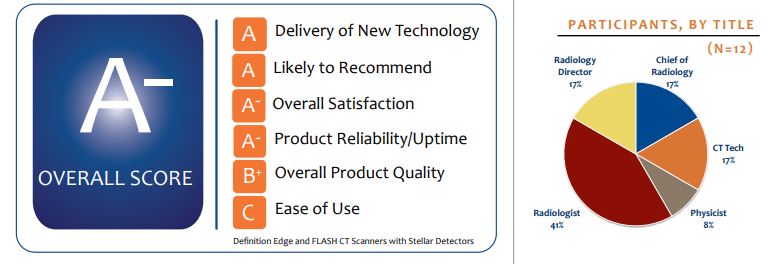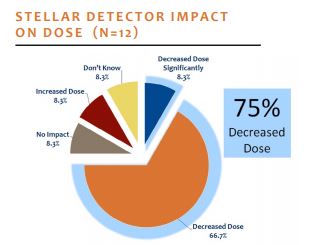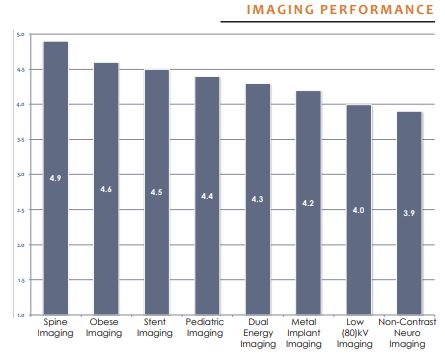 2024 BEST IN KLAS
2024 BEST IN KLAS
Preferences
Related Series


Siemens CT
How Stellar Can A Detector Be?
This KLAS technology review is a first peek globally at Siemens’ new Stellar Detector, a part of the new single-detector SOMATOM Definition Edge and dual-source Definition Flash, as well as an optional upgrade for existing SOMATOM Definition Flash and AS scanners. Specifically, we asked what value in patient care a new detector can have on a decades-old but highly reliable imaging modality. Moreover, how quickly can providers ascertain this value in an environment that increasingly demands real-time or near real-time information?

Worth Knowing
STELLAR DETECTOR CUSTOMERS ACKNOWLEDGE BENEFITS—Early adopters of Siemens’ Edge and Flash scanners with the Stellar Detector are seeing improvements in image quality, lower dose, and increased signal-to-noise ratio. Of respondents that compared CT images of patients using the Stellar Detector to scans without it, 75% (9 of 12) cite significant dose reduction. Several clients state the results are so dramatic that pediatric patients are only sent to a CT scanner with the Stellar Detector.
CUSTOMERS RECOGNIZE IMPROVED IMAGE QUALITY—Users are experiencing greater confidence in delivering higher diagnostic quality CT exams. Clarity is better and images have sharper edges, especially with 3D imaging.
SPINE AND OBESE-PATIENT IMAGING STAND OUT—Crisper images of the spinal canal and spinal discs and less noise and dose for images of obese patients push those exams to the top of the ratings for improvement using the Stellar Detector. Pediatric imaging is also much better overall using the new technology.
JURY STILL OUT ON LOW KV AND NONCONTRAST NEUROLOGY IMAGING—Opinions are varied on the impact of the Stellar Detector on low kV imaging, which users overall rate lower than other features. Fewer customers are able to comment on the detector’s impact on noncontrast neurology because of the newness of the installations, but this area receives the lowest functional score.
SYSTEM COMPLEXITY MAKES TRAINING IMPERATIVE—Protocol management and configuring the system optimally for specific exams are complex undertakings that put emphasis on training and education, which can impact the scanner’s ease of use for a few. Two of the 12 new customers had yet to see any increased image quality or dose reduction.
Why This Report?

Providers want to know how well new technologies are performing and if they are living up to vendors’ claims. Siemens’ new Stellar Detector is a new method of acquiring CT images. In order to understand how well this technology is working, KLAS reached out to 12 of the first 17 users in Europe and North America. With the regulatory processes that are in place, the European market was using the new detector several months ahead of the North American market.
This study identifies the realized benefits and challenges of the Stellar Detector with these early adopters. For such an undertaking to be free from bias and not serve as a marketing service for a vendor, or early condemnation sponsored by a competitor, it is important that KLAS start with a full client list and KLAS must be free to interview any or all of the clients. In that light, KLAS is committed to offering early performance reports that satisfy the appetite of interested providers.

Recognized as an innovator in low-dose CT, Siemens has recently bolstered their reputation and energized customers with development of the Stellar Detector as well as complementary technologies like iterative-reconstruction and doseoptimization tools.
A chief CT technologist in Europe said the dose reduction for children was a dramatic improvement: “We have started doing all pediatric scans on the Flash with the new detectors because the dose reduction is so impressive. Children are automatically sent to the Flash instead of to other scanners. Before the new Stellar Detectors, our DLP numbers were about 50 or 55. Now, our DLP numbers are about 30 or 35. That is a 30%–40% reduction in dose. Plus, we use SAFIRE now routinely. For a while, we did some reconstructions with SAFIRE and some without it and then compared them. Now, we use SAFIRE routinely, and we have a dose reduction of about 30% with most studies.”
A recurring theme in interviews with Stellar Detector users was the improved image quality and an associated higher confidence to deliver diagnostic-quality exams. While a few said they needed more time to realize the technology’s benefits and assess its impact on clinician diagnostic confidence, several customers articulated key advantages from being early adopters.

“We have been doing a lot of cases with the Stellar Detector,” said one provider. “Where it has really impressed us is when I do some of the 3D imaging. It is very impressive on the vessels. It creates very sharp edges. . . . It has very, very sharp edges. If I put them side by side, I can really tell a difference.”
Siemens’ Stellar Detector is a new enhancement to the vendor’s SOMATOM Edge and SOMATOM Flash CT scanners that has received high scores from early adopters in terms of quality, reliability, improved image resolution, and reduced dose. The reduced dose has won converts in pediatric imaging especially. Ease of use is an issue as protocol setting and configuration can be problematic without adequate investment in training. Overall, this is a high-end technology that requires thoughtful implementation in high-volume environments.
This material is copyrighted. Any organization gaining unauthorized access to this report will be liable to compensate KLAS for the full retail price. Please see the KLAS DATA USE POLICY for information regarding use of this report. © 2024 KLAS Research, LLC. All Rights Reserved. NOTE: Performance scores may change significantly when including newly interviewed provider organizations, especially when added to a smaller sample size like in emerging markets with a small number of live clients. The findings presented are not meant to be conclusive data for an entire client base.
